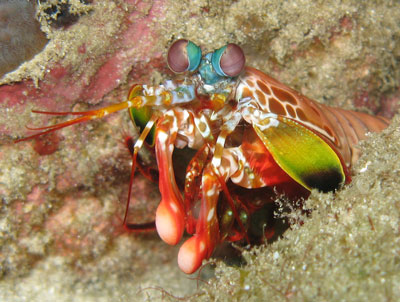Who knew that ceramics are a preferred material for body armour? Clearly, not me. According to the June 13, 2012 news item on Nanowerk, there’s a shrimp whose shell may offer inspiration for better quality ceramics used not only in military body armour but also in joint replacements. Here’s an image of one type of mantis shrimp,
Pretty, isn’t it? Here’ s more from the June 13, 2012 news item on Nanowerk,
A scientist from Nanyang Technological University (NTU) may be onto an ocean of discovery because of his research into a little sea creature called the mantis shrimp.
The research is likely to lead to making ceramics – today’s preferred material for medical implants and military body armour – many times stronger. These findings were published in last Friday’s Science (“The Stomatopod Dactyl Club: A Formidable Damage-Tolerant Biological Hammer” [behind a paywall]), and focused on the mantis shrimp’s ability to shatter aquarium glass and crab shells alike.
The common creature native to the Indo Pacific, has club-like ‘arms’ which can strike prey at speeds matching that of a 5.56mm rifle bullet. Each impact generates a force exceeding 50 kilograms, which is hundreds of times the mantis shrimp’s weight.
The June 13, 2012 news release from Nanyang Technological University (Singapore) notes,
Assistant Professor Ali Miserez, from NTU’s School of Materials Science Engineering (MSE) and School of Biological Sciences (SBS), collaborated with Dr James Weaver from Harvard University as well as scientists from the University of California-Riverside, Purdue University, and Brookhaven National Laboratory in the United States.
They have observed down to the nanoscale the highly unique composite structure of the mantis shrimp’s club and discovered that it is weaved together in a unique fashion to create a structure tougher than many engineered ceramics. This is the first time that the mantis shrimp’s club is studied in such detail.
“The highly damage resistant property of the mantis shrimp could be most useful in medical products such as hip and joint implants, as they sustain impacts hundreds of times daily during walking and daily activities,” said Asst Prof Miserez, a recipient of the National Research Foundation Fellowship, which provides a research grant of up to S$3 million over five years.
“Damaged hip implants are a real problem, and cost billions of dollars to the healthcare systems worldwide. They also cause painful surgeries to patients when they need to be replaced. Using a nature-inspired blueprint to design biocompatible implants is actually a ‘shrimple‘ solution.”
Thank you for that wordplay. ‘Shrimple’, indeed! More seriously, I have previously commented on hip replacements and the search for ways to improve them, most recently in my April 20, 2012 posting.
The June 13, 2012 news release from Nanyang Technological University goes on to discuss Dr. Miserez’s lab and other applications for the shrimp-inspired ceramic materials,
Designing a damage-resistant implant which is made out of a bio-compatible bone material would solve the above problems [bone loss, toxicity, and immune reactions], as the material exists naturally in the human body. Asst Prof Miserez, whose laboratory is situated at MSE’s Centre for Biomimetic Sensor Science, said they will continue their research to better understand the design and materials and will attempt to replicate it in the laboratory next year.
His team, which includes PhD student Shahrouz Amini, will be focusing on developing a new bio-compatible material which could be used for medical implants such as hip implants. However, the potential applications for these nature-inspired designs are widespread because the final product is expected to be lighter weight and more impact resistant than existing products. These could include new types of armour plating, lighter vehicles and tougher engine and aircraft components like pistons and gears, all of which suffer from impact, wear and abrasion damage over time. [emphasis mine]
Possible medical and military advances march hand in hand, again!
